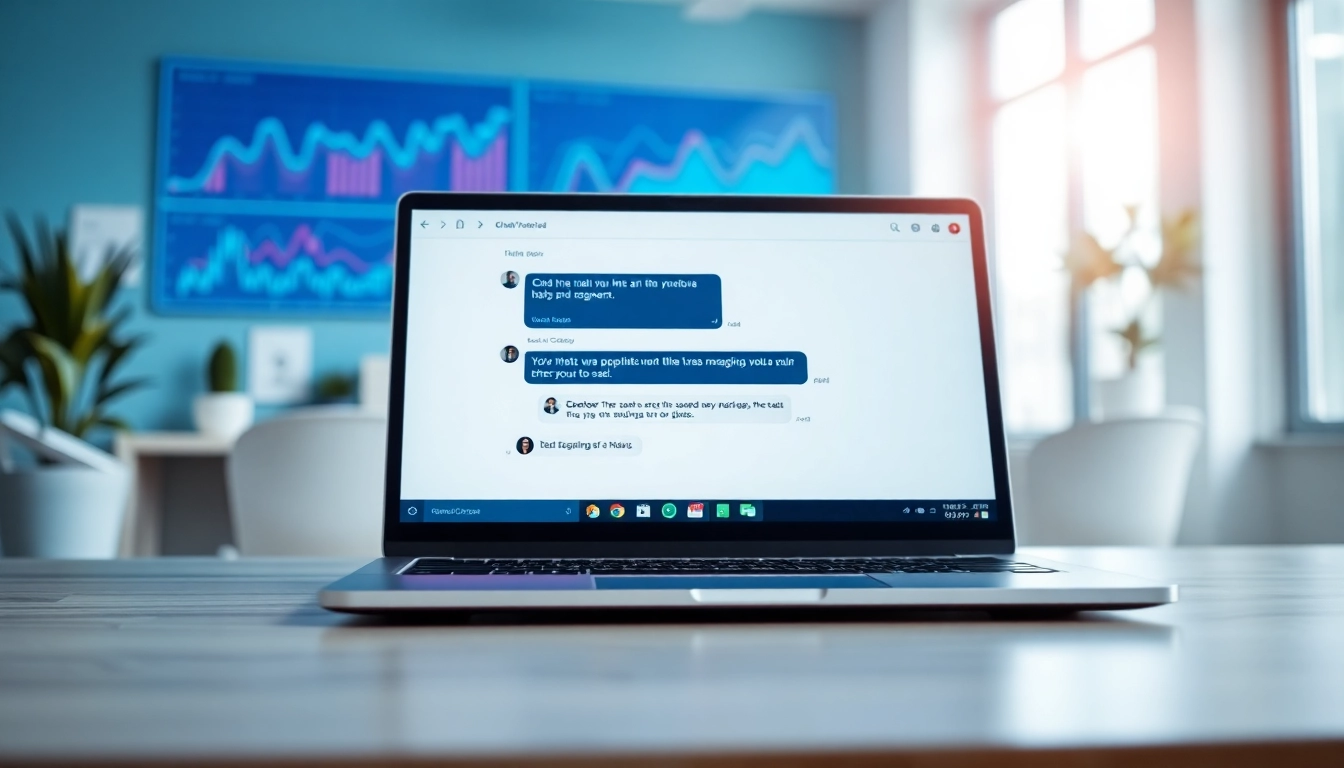Understanding ChatGPT Chatbots
What is a ChatGPT Chatbot?
A ChatGPT chatbot is an artificial intelligence-powered conversational agent designed to engage users in natural language conversations. Grounded in OpenAI’s Generative Pre-trained Transformer (GPT) architecture, these chatbots are capable of understanding and responding to text inputs in a coherent, human-like manner. Leveraging machine learning algorithms, they learn contextual nuances, making them proficient at adhering to various conversational styles and contexts.
Businesses are increasingly adopting chatgpt chatbots for customer service, support, and even lead generation, creating a seamless interaction experience for their users. Unlike traditional rule-based chat systems that rely on predefined responses, ChatGPT chatbots can draft replies on the fly, adapt to user inputs, and improve their performance over time through continuous learning.
How ChatGPT Works: A Technical Overview
The underlying technology of ChatGPT involves complex neural network architectures, particularly the transformer model, which excels at handling sequential data. It operates through two main stages: pre-training and fine-tuning. During pre-training, the model learns vast amounts of text from the internet, absorbing language patterns, grammar, facts, and some reasoning ability. This phase equips the model with general knowledge and linguistic skills.
In the fine-tuning phase, the model undergoes a targeted training set specific to the goals of the chatbot implementation. This may involve supervised learning from a set of example conversations and reinforcement learning, where the model learns from trial and error, enhancing its ability to provide accurate, contextually relevant responses.
Benefits of Integrating ChatGPT into Your Services
Bringing a ChatGPT chatbot into your service portfolio offers numerous advantages:
- Improved Customer Engagement: Chatbots provide instant responses, enhancing customer interaction and satisfaction.
- Cost Efficiency: Automating routine queries reduces operational costs associated with customer service.
- 24/7 Availability: Unlike human agents, chatbots can operate around the clock, providing support without downtime.
- Personalization: ChatGPT can tailor interactions based on user inputs, offering a bespoke experience that resonates with each user.
- Scalability: As business demands increase, chatbots can manage larger volumes of queries without additional investments in human resources.
Designing Your ChatGPT Experience
Key Features to Include in Your Chatbot
To create an effective ChatGPT chatbot, consider incorporating the following features:
- Natural Language Processing (NLP): NLP allows the chatbot to understand and process user inputs in real-time, leading to more accurate responses.
- Multilingual Support: Including multiple languages expands accessibility and allows you to reach a broader audience.
- Context Awareness: A chatbot should remember past interactions to provide relevant suggestions and follow-ups.
- Error Handling: Develop mechanisms whereby the chatbot can manage misunderstandings gracefully, perhaps by prompting users for clarification.
- Analytics Integration: By tracking user interactions, businesses can obtain valuable insights to enhance chatbot performance and user satisfaction.
Customizing Responses: Making It Unique to Your Brand
Customization is key to ensuring that a ChatGPT chatbot aligns with your brand’s voice and mission. This involves not only programming specific responses that reflect your company’s values but also teaching the chatbot to adopt the vernacular and tone typical of customer interactions. Consider developing a personality for your bot, assigning it a friendly tone or a formal style depending on your target audience. Remember, authenticity is crucial, as consumers value real, relatable interactions.
User Journey Mapping for Effective Interaction
User journey mapping is a method for visually depicting the interactions a customer has with your chatbot throughout their engagement process. By understanding each touchpoint, companies can optimize the chatbot to address customer needs effectively. Here are critical stages to consider in user journey mapping:
- Awareness: How do users discover your chatbot? This could come from social media, website prompts, or email campaigns.
- Engagement: What triggers users to start a conversation? This is typically through an intuitive interface or compelling call-to-action.
- Resolution: Assess how effectively the chatbot solves user queries and offers solutions.
- Feedback: This involves collecting user feedback to understand the overall experience and areas for improvement.
Implementing Your ChatGPT Chatbot
Step-by-Step Guide to Deployment
Deploying a ChatGPT chatbot involves a series of critical steps:
- Define Objectives: Clearly outline what you hope to achieve with your chatbot, whether it’s improving customer service, generating leads, or providing product support.
- Select the Right Platform: Choose a service provider (like GetButton) suitable for your business needs, ensuring they offer flexible integration options.
- Design Conversations: Map out sample dialogues that the chatbot should engage in, considering various user intents and responses.
- Build the Chatbot: Utilize user-friendly interfaces or development environments provided by the chosen platform to create the bot.
- Test Your Bot: Before launch, conduct rigorous testing with different user scenarios to ensure performance accuracy and reliability.
- Launch: Deploy your chatbot across the desired platforms, taking care to educate users about its capabilities.
- Monitor and Adjust: After deployment, monitor interactions and continuously update the bot to improve responses based on user feedback.
Common Challenges and How to Overcome Them
Implementing a ChatGPT chatbot can come with challenges, including:
- Inaccurate Responses: Users may receive unexpected or off-point responses. Regularly retraining the model and expanding your dataset can help reduce inaccuracies.
- User Resistance: Some users may prefer human interaction. Engage users through effective communication about the chatbot’s capabilities and benefits.
- Integration Issues: Ensure compatibility with existing systems by performing thorough assessments of your tech environment before integration.
- Security Concerns: Implement robust data security protocols to safeguard user information and build trust.
Best Tools for Integration with Existing Platforms
Several tools facilitate the integration of ChatGPT chatbots with existing platforms, notably:
- Zapier: A popular tool that allows integration between multiple web applications effortlessly.
- API Connections: Custom APIs can bridge the gap between the ChatGPT bot and other software solutions.
- Chatbot Builders: Platforms like Dialogflow and ManyChat offer built-in tools for easy integration.
- Customer Relationship Management (CRM) Systems: Integrating your chatbot with CRM platforms can enhance customer experiences by providing personalized interactions.
Measuring the Success of Your ChatGPT Chatbot
Key Performance Indicators (KPIs) to Track
Measuring the impact of your ChatGPT chatbot is critical to understanding its effectiveness. Key performance indicators include:
- Engagement Rate: Track how many users interact with the bot and how frequently they engage.
- Response Accuracy: Measure the percentage of correct responses received compared to user inquiries.
- Customer Satisfaction Score (CSAT): Deploy surveys post-interaction to gauge satisfaction levels.
- Completion Rate: Analyze how often users successfully resolve their inquiries through the chatbot without human intervention.
- User Retention: Monitor how many users come back to engage further with the bot.
Gathering User Feedback and Continuous Improvement
Continuous improvement of your ChatGPT chatbot depends on user feedback. Regularly analyze user interactions to identify pain points or areas where the bot may be underperforming. Implementing feedback loops, such as follow-up surveys or immediate post-chat feedback requests, can facilitate gathering this essential data. This process allows for ongoing adjustments that enhance the chatbot’s performance and satisfaction levels.
Case Studies: Success Stories and Lessons Learned
Successful implementations of ChatGPT chatbots span various industries. Here are a couple of examples:
- E-commerce: An online retail brand implemented a ChatGPT chatbot to assist customers in product selection and order tracking, resulting in a 25% increase in customer satisfaction and a distinct reduction in response times.
- Healthcare: A telemedicine provider adopted a ChatGPT bot to triage patient inquiries, which subsequently scaled operations, enabling the handling of 40% more inquiries without additional staff.
Future Trends in ChatGPT Chatbots
Emerging Features and Capabilities
As technology continues to advance, the capabilities of ChatGPT chatbots are expected to grow tremendously. Anticipated features may include:
- Enhanced Emotional Intelligence: Future chatbots may utilize sentiment analysis, identifying user emotions and adjusting responses accordingly to create more empathetic interactions.
- Voice Capabilities: Chatbots may incorporate voice recognition technologies, allowing users to interact verbally for added convenience.
- Visual Recognition: Future iterations might include the ability to interpret and respond to visual inputs, allowing users to send images or videos for context-rich conversations.
The Role of AI in Enhancing User Experience
AI’s influence on user experience is profound, enabling businesses to personalize interactions and enrich the customer journey. Using data analytics, AI can predict user behavior and preferences, adjusting chatbot responses to not only meet but exceed customer expectations. By automating repetitive tasks and allowing customers to focus on more complex inquiries, AI-powered chatbots are paving the way for more meaningful interactions.
Preparing for the Future: A Strategic Outlook
To stay ahead of the curve, businesses must invest in evolving their chatbot technologies continually. This might involve collaborating with AI research organizations, participating in conferences, and keeping an eye on emerging trends. Companies need to remain proactive in their approach, embracing new developments and gathering user insights to refine their chatbot offerings continually.



